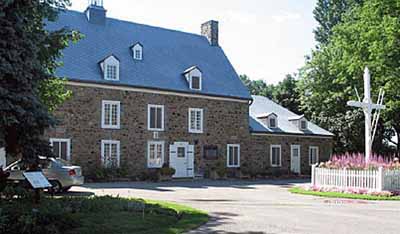Maison Saint-Gabriel National Historic Site of Canada
Montréal, Quebec

Exterior view
© Parks Canada Agency / Agence Parcs Canada, N. Clerk, 2005.
Address :
2146 Dublin Place, Montréal, Quebec
Recognition Statute:
Historic Sites and Monuments Act (R.S.C., 1985, c. H-4)
Designation Date:
2007-06-08
Dates:
-
1668 to 1668
(Construction)
-
1698 to 1698
(Significant)
-
1826 to 1826
(Significant)
Event, Person, Organization:
-
Marguerite Bourgeoys
(Person)
-
Congrégation de Notre-Dame de Montréal
(Organization)
-
Pierre Couturier
(Builder)
-
Gilbert Maillet
(Builder)
-
Jean Deslandes
(Builder)
-
Langenois Tesserot
(Builder)
-
Antoine Tesserot
(Builder)
Other Name(s):
-
Maison Saint-Gabriel
(Designation Name)
Research Report Number:
2005-056
Plaque(s)
Existing plaque: 2146 Dublin Place, Montréal, Quebec
At the heart of one of the oldest surviving farmsteads in Canada, this farmhouse is an exceptional example of French inspired rural architecture, notable for its rubble stone masonry, pitched roof, and wood frame. Purchased by Marguerite Bourgeoys in 1668, it was rebuilt in 1698 after a fire in 1693. For three hundred years it housed the Sisters of the Congrégation de Notre-Dame de Montréal, who operated the farm to supply their community. This remarkable building remains a unique surviving connection with the work of Marguerite Bourgeoys, a pioneering figure in education in Canada.
Description of Historic Place
Located in the southern part of Pointe-Saint-Charles in Montréal, at the end of Dublin Place, Maison Saint-Gabriel National Historic Site of Canada is situated at the centre of a property of irregular shape which also contains a barn constructed of field stone, a well and a wooden cross. Maison Saint-Gabriel is an example of French-Canadian architecture dating from the days of the French regime. The lot is an island of pastoral greenery in a large residential sector. The official recognition refers to lot 1 381 592 of the municipality of Montréal, where the historic site is located.
Heritage Value
Maison Saint-Gabriel was designated a national historic site of Canada in 2005 because: its remarkable features and construction techniques make it an exceptional example of rural architecture of the French Regime; and, for more than 300 years, it was home to the sisters of the Congrégation de Notre-Dame, who operated a farm, making it one of Canada oldest surviving farm properties.
The heritage value of Maison Saint-Gabriel derives from the fact that it is an exceptional example of the rural architecture of New France and it is associated with the religious work of Marguerite Bourgeoys and of the religious community Congrégation de Notre-Dame, which she founded.
Maison Saint-Gabriel is a remarkable building whose history and architecture are evocative of 17th-century New France. Erected on a rectangular plan, the impressive fieldstone house consists of a central body flanked by two small wings and topped by a steep, gable roof whose two slopes are pierced by small dormers, double chimneys and a belfry. Owing to its exterior composition, interior layout and construction techniques, it is an exceptional example of the rural architecture of New France.
It is also an exceptional testament to the religious work of Marguerite Bourgeoys and the Congrégation de Notre-Dame. Maison Saint-Gabriel was home to a small group of filles du roi (king's daughters), served as a primary school for young children and a homemaking school for young girls, and also served as a residence for nuns employed on a sharecrop farm.
Source: Historic Sites and Monuments Board of Canada, Minutes, December 2005.
Character-Defining Elements
Key elements contributing to the heritage value of this historic site include: the two-storey main body with a gable roof, the two slopes of which are pierced by small dormers, double chimneys and a belfry; the frame constructed of oak and ash beams fastened with mortise-and-tenon joints; the massive ceiling beams, wide floorboards, ironwork and fieldstone walls, up to 1.8 metres thick at the foundation; the windows with wooden shutters on the inside, the three large stone fireplaces, the two stone sinks, and the original wall cabinets; the two-level attic; the chapel and dormitories for the nuns; the main body lean-to, which is the oldest part of the house, and the west lean-to with its pavilion roof; the original elements of the basement, including the rough beams, the two stone bases supporting the fireplaces, and the small shuttered windows; the original furnishings, as well as the articles that belonged to Marguerite Bourgeoys, the nuns and the filles du roi, including spinning wheels and gifts provided by King Louis XIV, such as dinnerware and utensils; the well (1670) and the wooden cross (1818).